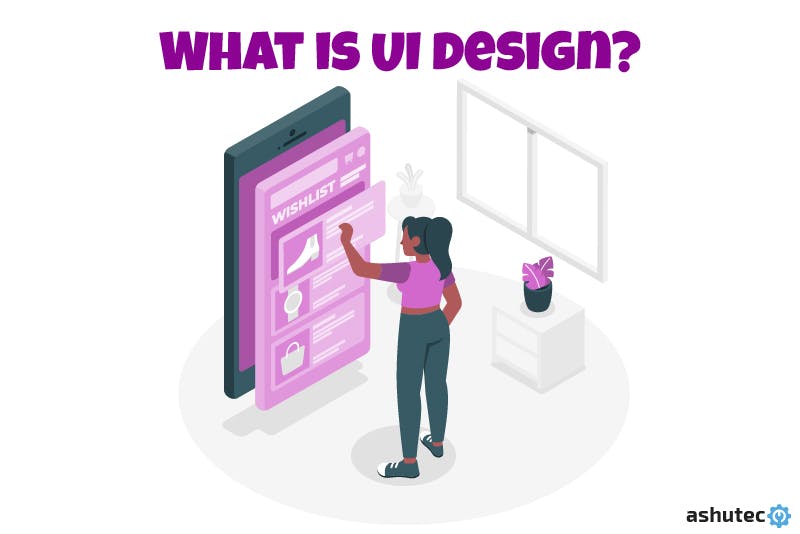Let’s Connect!
Work can be a fun when we know and understand each other well. Let's start conversation to new beginning
+91 63542 35108
To discuss what we can do for you Give us a Call
connect@ashutec.com
Tell us about your next project Write to us

Designing is an important aspect of any business if the presentation of the product is eye-catching and unique, then you will attract customers to your product. For software and application development, good design is essential because it can enhance functionality, improve user experience, establish branding, enhance productivity, and give a competitive edge. Companies may produce goods that are useful and appealing to people by investing in design.
The Stanford Research Institute developed the first graphical user interface (GUI) in the 1960s (SRI). This innovation paved the way for the creation of the mouse and other input tools that facilitated user interaction with computers.
A GUI with windows, icons, and menus was developed at Xerox PARC in the 1970s for the Alto computer. The Macintosh computer and other contemporary GUIs were eventually created using this design as inspiration.
User interface design is referred to as UI design. It refers to the layout of the interactive and visual components of a digital product, such as software, mobile apps, and websites. Creating a user interface that is aesthetically pleasing, simple to use, and intuitive is the aim of UI design.

The visual components that users view and interact with, including buttons, icons, menus, and color schemes, are the main emphasis of UI designers. For the purpose of creating mockups and wireframes of the user interface, designers use design software like Adobe Photoshop or Sketch. To make sure that the finished product is effective and satisfies the demands of the user, UI designers also work closely with other team members like UX designers, developers, and project managers.
The development of digital products must include UI design because it contributes to a satisfying user experience. An intuitive user interface can make it simpler for people to utilize a product, finish activities, and accomplish their objectives. It can also improve user engagement and build the brand's identity. For digital products to be both aesthetically pleasing and user-friendly, good UI design is essential.
User experience design, or UX design, is the process of designing digital goods with an emphasis on giving people satisfying and meaningful experiences. This covers all aspects of the product, from its general design and construction to the specifics of how people interact with it.

UX designers develop wireframes and prototypes that specify the overall structure and flow of the user-centered design. To guarantee that the finished mobile design or web design satisfies the user's needs, they also work along with other team members like UI designers, engineers, and project managers.
UX design is essential because it has a big impact on how satisfied and engaged users are with a product. A good user experience can make it simpler for users to achieve their objectives, which can boost user loyalty and improve company results.
To comprehend the needs, preferences, and behaviors of users, UX designers do research. They use this data to develop user personas and user journeys, which enable them to identify the user experience's weak points and potential development areas.
The development of digital goods that are both efficient and pleasurable for users can benefit from excellent UX design, which takes into account aspects like accessibility, usability, and emotional involvement.
Maintain Simplicity: The secret to successful UI/UX design is simplicity. It entails maintaining a clear, uncluttered, and understandable design. Users will be able to focus on the information and navigate your interface more easily as a result.
The importance of simplicity in successful UI/UX design cannot be overstated. Maintain a simple, clear, and understandable design. Make sure your interface is simple to utilize for the user and that the design components are eye-catching without being distracting. Straightforward designs are more user-friendly and aid in keeping the user's attention on the information.
Understand Your Users: Creating effective UI/UX requires an understanding of your people. To determine your users' wants, objectives, and pain spots, conduct user research. Create user personas and scenarios using this information to better understand how your users will engage with your product. This will enable you to create a user-friendly interface that satisfies their needs.
Understanding the demands, objectives, and points of your users is essential to designing good UI/UX. Create user personas and scenarios using user research to better understand how people will engage with your product.
Use Visual Hierarchy: Visual hierarchy is the positioning of design elements to convey their hierarchy. This aids in directing the user's attention to the page's most crucial components, such as calls to action or significant information. Your interface becomes more user-friendly and intuitive as a result.
The user can explore the interface more simply and discover the information they need with the aid of a well-designed visual hierarchy. Also, it can aid in giving the design a sense of structure and order.
Design Patterns Consistency: An intuitive user experience is produced by using consistent design patterns. Colors, font, and layout should all be used consistently throughout your product.
Use consistent design components like typeface, colors, and layout to produce a consistent design. This involves using a uniform grid system, a consistent color scheme, and the same typeface and font size throughout your product. Also, you ought to follow a consistent strategy for placing links, buttons, and menus.
A strong visual identity for a product is developed through consistent design, which helps set it apart from rivals. Also, it contributes to the development of professionalism and trust, both of which can enhance how the user views your brand and product.
Use Responsive Design: Responsive design is a technique for designing user interfaces that can change to match various screen sizes and devices. This is essential because users might use desktop computers, smartphones, tablets, and other gadgets to access your interface. Make sure your interface looks amazing and is simple to use regardless of the device being used by using responsive design.
The main objective of responsive design is to give users easy access to a website's or application's content regardless of the device they are using. This means that, despite screen size, the material should be simple to read and navigate. This is accomplished using responsive design, which makes use of media queries, fluid images, and flexible grids and layouts.
Flexible grids and layouts enable the information to adapt to the size of the screen, ensuring that the design is consistent and readable on all platforms. Media queries enable the design to adjust to multiple devices and resolutions, while fluid images guarantee that images resize appropriately to meet the screen size.
Use Feedback: The user is informed of what is happening in the interface by feedback, which is key in UI/UX design. Utilize feedback to let the user know what they did, for as when they clicked a button or submitted a form. This contributes to a more interesting and educational user experience.
Animations, highlighting, or altering the color of a button or element are just a few examples of visual feedback. To show that a user's click has been registered, a button can, for instance, animate or change color when they press it.
Auditory feedback may take the form of notifications or sounds that signal a successful action or an error. For example, a sound could be played to signal that a user has successfully submitted a form when it is submitted. On the other hand, if a user submits an invalid input into a form field, an error sound may start to play to let the user know that something is wrong and needs to be fixed.
Feedback is an essential aspect of designing user interfaces that are interesting and educational. By soliciting input from the user, you may improve the user interface and make it less annoying, which will enhance user engagement and satisfaction.
These are some key points to remember if you want an effective user interface and user experience.
Let’s discuss the future of UI UX design, these trends are likely to impact UI/UX design in the future, and designers who keep up with these developments will be better equipped to produce interesting and successful UI UX design that satisfy customers' needs.
Personalization: With the advancement of AI and machine learning technology, digital products will be able to tailor user experiences in real-time. Due to the ability to develop highly tailored user experiences, businesses will be able to boost customer engagement and loyalty.
The technique of personalizing a user's experience to match their particular wants and interests Digital products will be able to personalize user experiences in real-time based on variables like past behavior, demography, and context as AI and machine learning technologies progress. Due to the ability to develop highly individualized user experiences, businesses will be able to boost customer engagement and loyalty.
Voice Interfaces: As voice assistants like Amazon's Alexa and Google Home become more popular, our interactions with digital objects are altering. To accommodate this new paradigm, UI/UX designers will need to develop interfaces that are voice-based interaction-optimized.
The rise of voice assistants like Google Home and Amazon's Alexa is altering how we interact with digital goods. Designing interfaces that are optimized for voice-based interactions, such as natural language processing and voice recognition, will require UI/UX professionals to adjust to this new paradigm.
Virtual and Augmented Reality: As these technologies become more widely available, they will open up new possibilities for developing immersive and interesting user experiences. To accommodate this new media, UI/UX designers will need to develop interfaces that function properly in 3D contexts.
These technologies will open up new possibilities for developing entertaining digital products like virtual showrooms, training simulations, and gaming experiences as they become more widely available. It will be up to UI/UX designers to adjust to this new format and design interfaces that are fully compatible with 3D settings.
Design Ethics: It is becoming increasingly clear that UI/UX has a big impact on user behavior, thus designers need to think about the ethical implications of their work. It will be necessary to place more emphasis on user security, privacy, and well-being.
In light of the increasing knowledge that UI/UX design significantly affects user behavior, designers must take the ethical implications of their work into account. It will be necessary to place more emphasis on user security, privacy, and well-being.
Simplicity: The emphasis will be on creating clear, clear interfaces that are simple to use and comprehend, with the minimalism and simplicity trends in UI design expected to continue.
Focusing on straightforward, attractive design components like font, color, and negative space defines minimalist design. This method makes it easier to design intuitive and aesthetically pleasing user interfaces, which can increase user happiness and engagement.
Successful software development and website design depend heavily on UI/UX design. A clear and engaging user experience (UI/UX) enables users to interact with digital products while also addressing their demands and objectives. The UI/UX design guidelines and best practices we've covered can assist designers in producing interfaces that are visually appealing, simple to use, and user experience-focused. New methods and trends will continue to appear as technology develops, but good UI/UX design will always be based on the fundamentals of user-centered design. ashutec helps you to develop digital products that are both useful and enjoyable to use. It prioritizes the demands and behaviors of the user, increasing user pleasure, engagement, and success.

